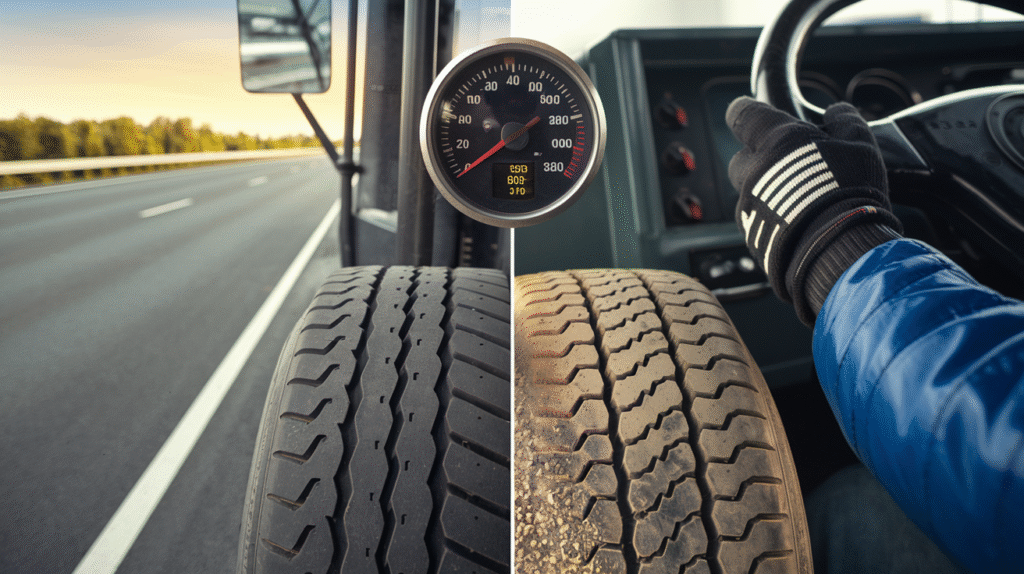What psi should semi truck tires be: A Comprehensive Guide
what psi should semi truck tires be? For truck owners and retail shop dealers with semi-trucks, understanding the correct tire pressure is crucial. Proper tire inflation not only ensures safety on the road but also impacts fuel efficiency, tire wear, and overall vehicle performance. In this guide, we’ll explore the question: what PSI should semi truck tires be?
Factors Influencing Semi Truck Tire Pressure
Load Capacity
The appropriate tire pressure for a semi truck largely depends on the load it’s carrying. Heavier loads require higher tire pressure to maintain proper support and prevent excessive tire deformation.
Tire Size and Type
Different tire sizes and types have varying recommended pressure ranges. It’s essential to consult the tire manufacturer’s guidelines for specific recommendations.
Weather Conditions
Temperature fluctuations can affect tire pressure. Cold weather tends to decrease tire pressure, while hot weather can increase it. Regular pressure checks are crucial, especially during extreme weather conditions.

Recommended PSI Ranges for Semi Truck Tires
While the exact PSI can vary based on the factors mentioned above, here are some general guidelines:
- Steer tires: Typically inflated to 110-120 PSI
- Drive tires: Usually inflated to 100-110 PSI
- Trailer tires: Often inflated to 100-110 PSI
Note: These are general ranges. Always refer to the specific tire manufacturer’s recommendations for precise PSI values.
The Risks of Incorrect Tire Pressure
Underinflation
Underinflated tires can lead to:
- Increased fuel consumption
- Uneven tire wear
- Reduced handling and stability
- Higher risk of tire failure
Overinflation
Overinflated tires may result in:
- A harsher ride
- Reduced traction
- Increased vulnerability to road hazards
- Uneven tire wear in the center of the tread
How to Check Semi Truck Tire Pressure
Tools Needed
- Accurate tire pressure gauge
- Air compressor
- Valve core tool (for replacing faulty valve cores)
Step-by-Step Process
- Check tire pressure when tires are cold (before driving or at least 3 hours after driving)
- Remove the valve cap
- Press the tire gauge firmly onto the valve stem
- Read the pressure displayed on the gauge
- Compare the reading to the recommended PSI
- Add or release air as necessary
- Replace the valve cap
Maintaining Proper Tire Pressure
Regular Inspections
Implement a routine tire pressure check schedule. For most semi trucks, checking tire pressure at least once a week is recommended.
Pre-Trip Inspections
Encourage drivers to perform a visual tire inspection before each trip, looking for signs of underinflation or damage.
Use of Tire Pressure Monitoring Systems (TPMS)
Consider installing a TPMS on your semi trucks. These systems provide real-time tire pressure information, alerting drivers to potential issues before they become serious problems.

The Impact of Proper Tire Pressure on Business Operations
Fuel Efficiency
Correctly inflated tires can significantly improve fuel efficiency. Even a small improvement in MPG can lead to substantial cost savings over time, especially for fleets.
Tire Longevity
Proper inflation extends tire life, reducing the frequency of tire replacements and associated costs.
Safety and Liability
Maintaining correct tire pressure reduces the risk of tire-related accidents, potentially lowering insurance premiums and mitigating liability risks.
Environmental Considerations
Proper tire inflation contributes to reduced fuel consumption and tire wear, which in turn lowers carbon emissions and reduces the number of tires that end up in landfills.
Educating Drivers and Maintenance Staff
Training Programs
Implement training programs to educate drivers and maintenance staff about the importance of proper tire inflation and how to check and maintain correct tire pressure.
Documentation
Provide easy-to-reference guides or charts showing the correct PSI for different tire types and load conditions.

Conclusion
Understanding what PSI semi truck tires should be is crucial for safety, efficiency, and cost-effectiveness in the trucking industry. While general guidelines suggest a range of 100-120 PSI depending on the tire position, it’s essential to consider factors such as load, tire type, and manufacturer recommendations.
For truck owners and retail shops, implementing a comprehensive tire maintenance program that includes regular pressure checks, driver education, and the use of modern tire pressure monitoring systems can lead to significant benefits. These include improved fuel efficiency, extended tire life, enhanced safety, and reduced operational costs.
Remember, tire pressure management is not just about meeting a specific PSI number; it’s about maintaining the optimal pressure for each specific situation. By prioritizing proper tire inflation, you’re investing in the longevity of your vehicles, the safety of your drivers, and the overall success of your operations.
Looking to purchase truck tires in bulk? Reach out to us today, and our team will connect you with a reputable wholesale supplier in Thailand. We ensure access to high-quality products, competitive pricing, and a dependable supply chain tailored to meet your large-scale procurement needs.







